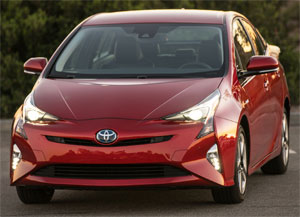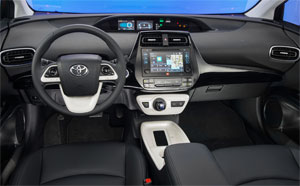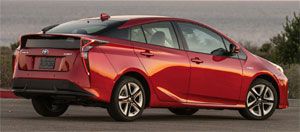2016 Toyota Prius
While almost every major car brand offers some form of hybrid vehicle, it’s Toyota that is truly the hybrid champ, with over 8 million hybrids on the road worldwide. And the vast majority of them are the hybrid that started it all, the Prius. Well, believe it or not, now it’s time for a 4th generation of the popular gas-electric. Let’s see if it’s still a green-machine benchmark.
Not only is this 2016 Toyota Prius all-new, but it’s built on Toyota’s New Global Architecture that will carry a wide variety of new models in years to come; not just hybrids.
And while that might be mostly about cutting costs and simplifying production, it’s a much stiffer platform that is supposed to deliver a more rewarding driving experience; not a past Prius strong suit. Is this the fun to drive Prius we’ve been waiting for?
Well, a first-time double wishbone independent rear suspension is certainly an upgrade over the former torsion beam. It provides both a smoother reaction to bumps, and better grip in corners.
Now, we’re not saying it can now moonlight as a track day ride, but there is clearly a better, more in control feel behind the wheel. Furthermore things have gotten quieter and visibility has improved all around.
 Prius is longer than before, by over 2-inches; and appears less bulbous, if also less familiar. In fact, a taller front grille area, most probably for pedestrian crash protection, and a flatter, more defined hood, alters the traditional Prius triangular profile significantly. The stance is wider, lower, and with lots of front fascia character lines, far more aggressive.
Prius is longer than before, by over 2-inches; and appears less bulbous, if also less familiar. In fact, a taller front grille area, most probably for pedestrian crash protection, and a flatter, more defined hood, alters the traditional Prius triangular profile significantly. The stance is wider, lower, and with lots of front fascia character lines, far more aggressive.
Lighting is a big contributor to that theme too, from the standard, menacing slim LED headlights, to the form following signature tails.
New looks and improved driving capabilities are great, but Government Fuel Economy Ratings are far more important to the Prius buyer. While not yet finalized, Toyota estimates 54-City, 50-Highway, and 52-Combined. Or overall, 2 more than last year.
There will also be an Eco model with lighter weight and enhanced aerodynamics that will push the numbers even higher, to 58-City, 53-Highway, and 56-Combined.
As for the hybrid gasoline-electric powertrain behind those gains, it has gotten lighter and more compact.
The gas-fed internal combustion part remains a 1.8-liter I4; but it’s been redesigned top to bottom. And while fuel efficiency is up, power is down. Total output now comes at 121-horsepower.
Transmission remains a CVT, with a combined transaxle/electric motor that is also smaller and more efficient. If only we could figure that trick out for ourselves.
 The powertrain space saving translates to more space inside. It was already a pleasant, if not super comfortable environment, but now it’s been upgraded to be a bit more mainstream and perhaps more inviting, but there is still plenty of that “Prius feel” remaining to keep it unique.
The powertrain space saving translates to more space inside. It was already a pleasant, if not super comfortable environment, but now it’s been upgraded to be a bit more mainstream and perhaps more inviting, but there is still plenty of that “Prius feel” remaining to keep it unique.
The instrument panel now has a hint of a wraparound theme to it, and controls are more in-line with the rest of the Toyota car family. Yet, the wide, and very comprehensive full-color TFT gauge cluster remains in a centrally located dash top bubble.
Steering wheel controls are even more comprehensive, and of course there’s a big center touchscreen for navigation and the like.
Front seat comfort and support have never been Prius strong points. 20-16 makes another stab at correcting that. The cockpit feels wide and airy, and there is excellent small item storage. The rear seat is also more comfy even as the space retains its coziness.
Cargo space is up slightly as well, to 24.6 cubic-ft. with a spare tire, 27.4 without; thanks to the smaller battery pack which is now Lithium-ion in most models, and now located completely under the rear seat.
 It seems like everything you buy these days, whether it’s a toaster or toilet boast increased safety, and for ’16 the Prius gets Toyota’s Safety Sense, with Lane Departure Alert, Radar Cruise, Pedestrian Detection, and other active features to keep you from hitting anything or anyone; making the new Prius a borderline autonomous machine.
It seems like everything you buy these days, whether it’s a toaster or toilet boast increased safety, and for ’16 the Prius gets Toyota’s Safety Sense, with Lane Departure Alert, Radar Cruise, Pedestrian Detection, and other active features to keep you from hitting anything or anyone; making the new Prius a borderline autonomous machine.
Pricing starts off at exactly the same place as the outgoing model at $25,035. A top end Four Touring starts just over 30 Gs.
We’ve been down this road three times before with Toyota. As like many of their recent products, their hope is that the 2016 Prius will transition from being a rational purchase to an emotional one. We’re not sure it’s quite there, yet. But bottom line, the Prius will continue to do what it has done for years, expand the hybrid profile to more and more households, and be the gasoline/electric benchmark for others to follow.
Specifications
- Engine: 1.8 liter I4
- Horsepower: 121
- Torque: 105 lb-ft.
- EPA: 54-City /50-Highway
2024 Toyota Land Cruiser
Toyota’s Go Anywhere Globetrotter Returns To U.S.
Every once in a while, we all need a reset. A time to get back to basics and prioritize the things that really matter. Well, for the Toyota Land Cruiser that time is now. So, let’s find out if that means bigger and better things for Toyota’s iconic off-roader.
The Toyota Land Cruiser’s status among the global off-road community is legendary, and it’s hard to imagine there’s any corner of the earth where a Land Cruiser hasn’t kicked up a little dust or mud. Well, 2024 sees the return of the Land Cruiser to the U.S. market after a 3-year hiatus, getting a major reset for the journey.
The reset comes mostly by no longer being based on the large three-row “300-series” chassis, but a new version of the smaller “200-series,” now known as the J250. As with the latest Tacoma, it uses the Tundra pickup’s full-size steel frame.
While the main Land Cruiser model, which goes by simply Land Cruiser, is packed full of luxury and convenience features, there is also a stripped-down model known as the 1958, honoring the first year the Land Cruiser made landfall here in North America. And it is that 1958 we have here, and we were glad to see it, as it also celebrates the original’s back-to-basics approach as a blank canvas for you to personalize as you tackle more and more adventures.
Not that it’s fully stripped down, as 8-inch touchscreen infotainment, a 7-inch full-color multi-information display, and automatic climate control are still standard. Plus, some seriously durable materials, and great heated cloth front seats that throw off some get serious 1990s Tacoma vibes.
But outside, there’s a definite lack of flashy trim and basic looking 18-inch wheels with Yokohama Geolander all-season tires; plus, big chunky bumpers and tilt-up back glass, which is a rarity that we appreciate. Though there is a little too much plastic in places that are sure to see some abuse if you do any significant off-roading.
It even feels a little rough around the edges, but for us it just adds to the rugged old-school utility vibe in a good way.
We did just that, both here in the Mid-Atlantic as well as in the California desert; and while there are some tech-forward driving aids, the actual hardware is in most cases plenty to get things done. That includes standard full-time dual-range four-wheel-drive, locking center and rear diffs, and 8.7-inches of ground clearance. A front stabilizer bar disconnect is also available to allow for increased articulation.
Who needs a V6 or even a V8 when you’ve got Toyota’s i-FORCE MAX setup at your disposal with 326 horsepower and 465 lb-ft of torque coming from a 2.4-liter turbo-four with an electric motor sandwiched between the engine and its eight-speed automatic transmission. Low speed torque delivery is impressive. It even feels a little rough around the edges, which may be a turn off to some, but for us it just adds to the rugged old-school utility vibe in a good way.
And it certainly feels quicker than an off roader needs to be, with an instant torque dump as soon as we eased on the throttle at our Mason Dixon test track; helping us get to 60 in 8.1 seconds and through the quarter-mile in 16.3 seconds at 86 mph. Considering the Land Cruiser’s terrain conquering mission, it behaved quite well in our handling course; it was plenty responsive to inputs, with less body roll than we expected and plenty of grip from the tires. The steering was light and quick but as expected didn’t provide much feel. Other than significant nosedive, braking performance was exceptional. Only 107-feet to panic stop us from 60 mph.
With the shift to the smaller size, there’s no more third row available, and cargo capacity now comes in at 46.2 cubic-feet with a max of a still healthy 82.1. Now, the best part of the Land Cruiser’s return is the entry price of $57,445. That’s about 30-grand less than what the last Land Cruiser went for back in 2021.
Whether it’s over the top fashion trends, mullets, or zombies; just when you think they’re dead, they come roaring back to life. Of course, we’re much happier to see the resurrection of this 2024 Toyota Land Cruiser than any of those things. Toyota is one brand that still recognizes the value of full-framed rugged rigs and has also acknowledged that sometimes less really is more. The Godfather of Toyota off-roading is back and better than ever.







